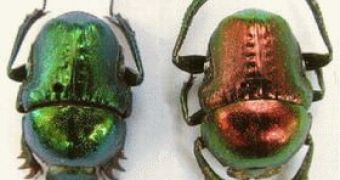Scarab beetles, forming one of the largest families in the animal kingdom with over 30,000 species, have fascinated humans for a long time.
Ancient Egyptians even worshiped them.
Could this have been due to their spectacular green or red glow?
Their bright colors have been a puzzle for the researchers, till recently, a team at University of Pretoria, South Africa, tackled the issue.
The researchers have discovered that the unusual reflection spectra is induced by defects in the structure of the exocuticle (the hard external shell), a model that could help researchers design nano chiral reflectors for future's display and laser technologies.
The investigated species was the south African Gymnopleurus virens.
In the early 1900s, this species was found to reflect almost entirely left-handed (left circularly polarized) light, and almost no right-handed light, being till now, the sole species known to display this phenomenon.
Now, the research team solved the asymmetrical preference: the exocuticle is made of many layers of microfibrils aligned parallel with each other, which induces a tendency for light polarized along their direction.
Each layer is slightly spun to the layer above, forming a helicoidal stack oriented to the left, which explains the left circularly polarized light. "Why nature may have given the scarab beetles the characteristic of reflecting only left-handed light is a difficult question," said co-researcher Johan Brink from the University of Pretoria, South Africa.
"Coloration in insects is usually some kind of trade-off between camouflage and an attempt to find a mate. In some cases (usually with yellow, black and red), it is a warning to predators that they are poisonous. My feeling is that these scarabs are trying to make themselves more visible by broadening the reflection band. At this point, however, it is only an idea which has not been proven in depth."
"By trial and error, we discovered that one could simulate the actual spectra quite closely by assuming some defects in the organization of the layers. Only when we had some idea what to look for, we discovered exactly how the beetles did the trick", said Brink.
Measuring light reflection by the exocuticle, the scientists detected deep modulations in the spectra induced by well-defined peaks, pointing to the existence of perturbations in the helicoidal layers.
Electron microscopy revealed the defect: though the layers of microfibrils look at first glance evenly spaced, at a point the layer spacing suddenly shifted by about 10%, fact that enlarges the reflectance band by up to four times than that from a perfect helicoidal stack.
As exocuticle is made of the same material, why are some scarabs red and some green?
The team detected just a variation in the thicknesses of the exocuticle layers. Various colors on different species, like the green edges on a red beetle, or blue edges on a green beetle, are determined by higher incidence angles. "We suspect that the green specimens grow a bit more slowly, possibly due to more arid conditions. The red specimens are found predominantly in wetter (and greener) areas, where they grow faster and produce thicker layers. This is then in line with the idea of making themselves more visible," said Brink.
"Possible applications of this kind of 'defect engineering' could be broadband laser reflectors for semiconductor lasers, and narrow-band spike filters that are sometimes used in spectroscopy to identify and classify materials and minerals," Brink explained.

 14 DAY TRIAL //
14 DAY TRIAL //